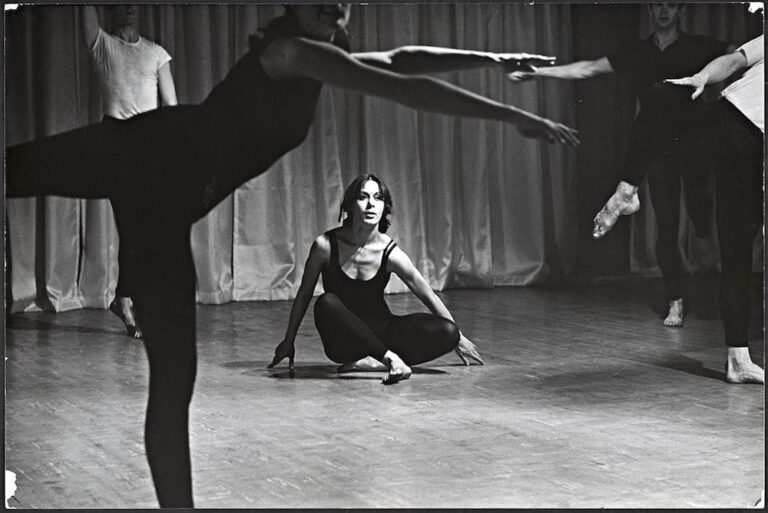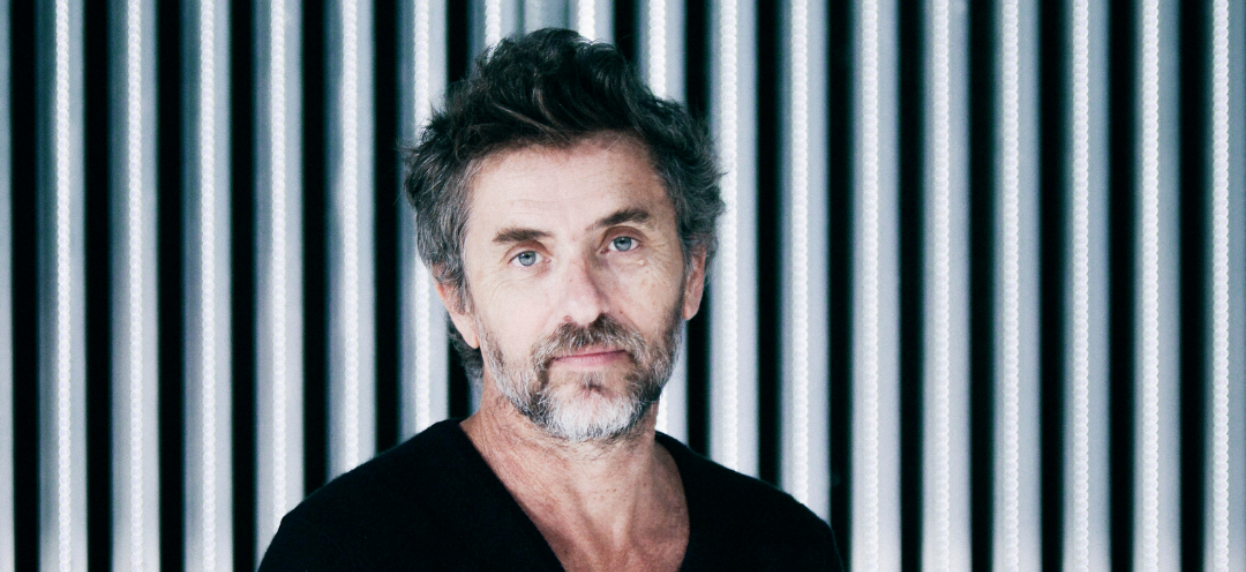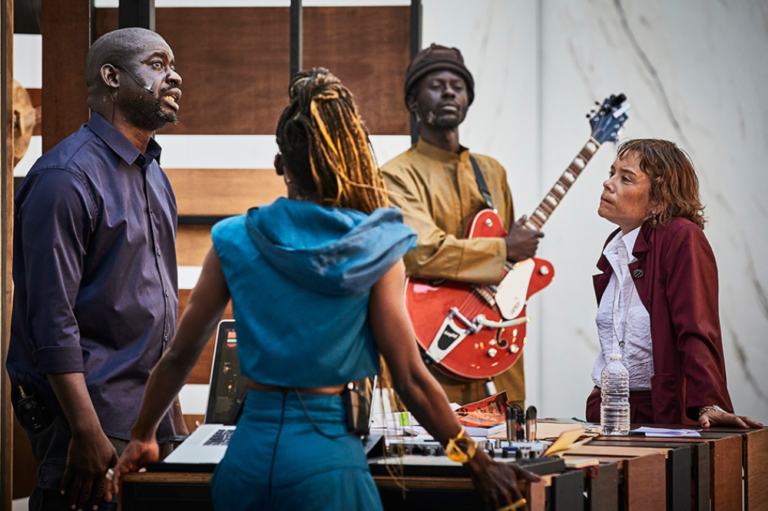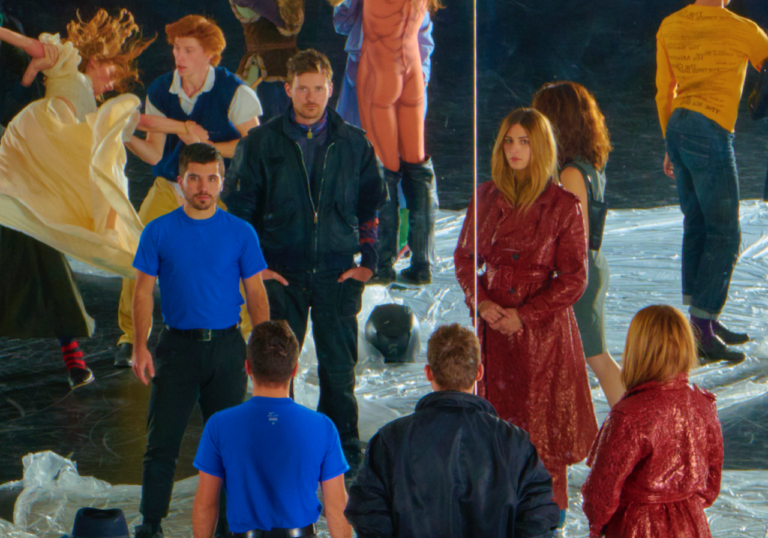
Pascal Rambert: “You get close to accuracy by concentrating on the truth of the actor’s body”

By Nicole Birmann Bloom
What does it mean to perform a play 30 years after its creation, in another language? Author and director Pascal Rambert is no stranger to this exercise, since his theatrical works are staged all over the world. Here he gives us a few insights into his way of writing and working to find forms of life that come back into words through the actors’ bodies.
The Art of Theater and With My Own Hands are two monologues you have regularly restaged, and often presented as a pair. The former was first produced in 2007 and the latter in 1992, but these are timeless texts. Could you tell us about the articulation between the two texts and their passage in time? What does the form of the monologue mean to you as a playwright and a director?
If I remember correctly, I think this is the fourth or fifth version of these plays, with different actors and actresses in French and foreign versions, notably Italian and American ones. I’ve grown accustomed to restaging all my plays abroad and making new versions of them around the world, but these two plays started that process. A play dating from 1992 or 1993 is already another century, and it’s certainly a totally different era. But if you look closely at the way With My Own Hands was written, it’s truly the crucible of how I write today, without punctuation, with the intention of giving the sentence over to what I call the flow, a flow of consciousness. This play was at the root of my realization that I don’t write classical theater with a beginning, a middle, and an end, but that my work consists in creating moments, moments of awareness for the characters, extreme moments, moments of separation like in Love’s End, moments of difficult reunion like in Sisters, extremely intense rehearsal moments like in the appropriately titled Rehearsal. All the plays I make deal with extremely intense moments in life. That’s also the subject of With My Own Hands, through a character who is so starved for life that life is not enough for him, and who therefore decides to kill himself in a hedonistic relationship to the world, but also of disappointment about what the world can offer. The Art of Theater is a little different; it’s the story of an aging actor explaining the art of theater to his dog, telling the dog, shall we say, rather scandalous things about theater, on the way of considering this art I’ve been practicing for more than 40 years. There’s something rather provocative, and therefore interesting, about staging this play here in the United States, since it tackles all the clichés you can have about the art of theater, the way that texts should be interpreted and performed. Whatever country it’s in, it’s an attack on the culture of the era and the place where the play is staged.
You often write for actors and actresses like Audrey Bonnet, Stanislas Nordey (who performed your work at Princeton University), Marina Hands, Laurent Poitrenaux… Could you tell us about your own relationship to the actors and actresses that you direct? Do you write in the rehearsal room and on the stage, working on the text and changing it for the actors, or do you arrive with a text that doesn’t change but whose variations are established through your direction?
To be specific, I always write for the actors, both for my projects in France and abroad. I meet 10, 20, 30, 40, 50 of them…and it’s based on those meetings that I make a choice and start writing the play. But I never go to meet the actors with a preestablished idea of what I’m going to write, because it’s a process that always starts with my associations about the actors’ bodies and vocal ranges and their energy. For the restaging of With My Own Hands at PS21, I wanted to entrust those words to Ismaïl ibn Conner. I had seen Ismaïl in an Arthur Nauzyciel play, so I invited him to come do the play, to our mutual delight. The other actor the play rests on is Jim Fletcher. I had already worked with Jim on Love’s End when it was produced in New York a few years ago. Jim is peculiar in that his acting is extremely sober, you could nearly say he doesn’t act, and I had been wanting to work with him again for a long time. It didn’t happen this time, but I think I’ll ultimately write something specifically for him, like Richard Maxwell has done for years. In my eyes, Jim is a poet more than an actor, in his relationship to language. That’s why, after Nicholas Elliott translated the text into English, I wanted to have work sessions at the table with him and Jim. It’s one thing to translate a text so people can read it, or even to make subtitles, but it’s something entirely different when actors have to read it. At that point, you have to do that collective work to get the orality I cultivate in my way of writing in French closer to English, or American English orality.
In fact, this is an exercise I go through in Cantonese, in Mandarin, in Japanese, in Russian…in all the languages I work in around the world. The objective is not, strictly speaking, to change the text, but to get together with the translator and the actors to take the time to recover the energy of the sentence. Otherwise, you’re performing a dead language. It’s always very difficult, because I can’t speak all the languages into which my plays are translated, and I’m always asked how I can tell if the text is accurate when I work in Hong Kong or Beijing. My answer is that you get close to accuracy by concentrating on the truth of the actor’s body. When something is wrong in the sentence, you can see it in the body. Insofar as I rehearse nearly every day, and therefore spend my time watching actors, my eye has become more refined over the years. Today, I can spot when something is wrong pretty quickly. And I hear it very, very quickly. But we don’t modify the text, let me be clear about that; we try to find those forms of life that come back into the words and allow the actors to look for what we are always looking for on stage, which is to say life itself.
It’s as if a 3D sculptor were working with living matter…
Absolutely! We’re like carpenters constantly going back over the structure of their edifice, and it’s very beautiful. I’ve worked in Japan, and I’ve always been surprised to see that certain houses and certain temples are destroyed every 60 years so that the carpenters who build them can retain their know-how, so the gestures are maintained. It’s as if we had retained the way of building cathedrals in Europe. Those gestures have been lost today. In Japan, they’ve been maintained because people systematically destroy the old buildings to keep the human gesture that builds them, so the gestures don’t disappear. There’s something about translation close to that, meaning that at a certain point you always have to reassemble the translation and redo it to restore that life I was talking about.
Ismaïl ibn Conner and Jim Fletcher have both acted in France and Europe, but they remain American actors. Have you noticed specific cultural differences in the way they claim the text for themselves and in your relationship, compared to other countries where you’ve worked?
In answer to that, I have to tell you how much the work I do today was heavily influenced by American theater, when I started coming to work in the US in the eighties. My discovery of Richard Maxwell’s work was particularly important. His work is the polar opposite of classical European theater, with all its sets and costumes—in other words, of what we were used to. For me, he remains the absolute example of American hyper-realism, in which I found a form of poverty, in the positive sense of the term. That’s a direction I was able to explore when I headed Théâtre de Gennevilliers, by inviting Richard Maxwell himself, as well as Young Jean Lee, Nature Theater of Oklahoma, and many American artists who explore an extremely powerful form of the real onstage. All that to say that staging these two plays here is, in a certain manner, to bring them back to where they came from. These two plays were contaminated by my love for contemporary American theater, and particularly for the world of downtown* and experimental theater in New York. So today, these texts are coming back to the United States after having been staged in French at Princeton University, and if I had to identify a major difference, it is that both Ismaïl and Jim bring a kind of lyrical realism, or real lyricism to the text. These two actors’ internal intensity, their acting, are profoundly American. If I think about the Italian version, for example, there was something more lilting about it. Italian is a wave, while American English is a destination. That necessarily creates a different theater.
Since you mentioned how important a certain American theater has been in your work, could you tell us about your influences? What are your references, your inspirations?
I had a revelation about this recently, here in Chatham. I was thinking about a play called Finlandia, which I’ve just finished and which will be produced in September in Madrid. It’s a play for two Spanish actors, which is frankly very harsh; the relations between the two characters are bitter, painful, and I was asking myself where my interest in long monologues originated. It wasn’t the first time I asked myself the question, but I had never been able to answer. Suddenly, it struck me, I realized that it probably all started with the incredible monologue at the end of Jean Eustache’s film The Mother and the Whore, which I must have seen when I was 17 or 18. There’s something about that monologue, its tone, the fact that Eustache films it in a single very long shot with the actress facing the camera, which was like a scandal for the cinema of that time, that absolutely stunned me. That’s for the long monologues. There are also artists who give you authorization, as I experienced in the eighties when I started reading Thomas Bernhard. Since the age of 16 or 17, I’ve been working on a single sentence. Whether it’s With My Own Hands, Love’s End, The Art of Theater… or Finlandia, it’s always the same sentence continuing. I simply put it in different bodies, in different countries. That approach owes a great deal to Thomas Bernhard, who made me aware that you could give a form to inner struggles. Also in theater, I think of writers like Bernard-Marie Koltès–about whom I spoke a lot with Ismaïl ibn Conner, who has performed his work here in the United States–and Peter Handke, who has found a form for the inside of human beings’ brains. In literature, I obviously think of James Joyce and Virginia Woolf, all those writers who worked on the flow of consciousness to put it into words.
Recently, you worked with students at the school associated with the Théâtre National de Bretagne (TNB), which led to the play Dreamers. Could you tell us about your relationship with these very young actors who are making their debuts and starting their careers in a particularly complex world?
Unfortunately, I don’t have enough of these experiences, due to lack of time, but it’s not the first time I’ve worked with students: I also wrote Mont Vérité for the students at the Théâtre National de Strasbourg; Lac, for the excellent Swiss school La Manufacture; and, two years ago, Others, for the students of Princeton University. I do it from time to time because when I was 20, I myself loved certain artists, I loved certain directors who helped me a great deal. And it’s important to be with young people, with thirty-year-olds; it allows me to better understand a world I sometimes don’t understand. I try to do it once every year or two. Anyhow, when you do the work I do, age doesn’t count because you’re inhabited by an eternal curiosity, you enjoy eternal youth. At least, that’s what I thought when I recently ran into Peter Brook, who must be 92 or 93. So it’s not that I feel close to young people in their twenties, but many things bring us together. I like to listen to them and find a form for their worries. I had forgotten that when you’re 25 or about to turn 30, it can be dizzying. I like to put my ear to these torments of youth. In this case, by writing Dreamers–which is really the translation of the French word “rêveurs,” and has nothing to with the Dreamers here in the US–I asked them to send me their dreams by email and voicemail for two years. I gathered a huge amount of material from which I was able to start writing texts for them; it was very beautiful, like diving into the unconscious of an entire generation. In the end, I came to a very personal, unexpected photograph of young people who are anything but normative. You see the unconscious at work, and it’s amazing.
*Editor’s note: Downtown theater refers to the world of alternative, often experimental and non-commercial theater that developed out of performance spaces below 14th Street in Manhattan starting in the 1960s and 1970s. With the gentrification of lower Manhattan, downtown theater has scattered around the city, and no longer has a specific geographic connotation.
Translated from the French by Nicholas Elliott.
In residency at PS21 Chatham, New York with actors Jim Fletcher and Ismaïl ibn Conner and translator Nicholas Elliott, Pascal Rambert is producing English-language versions of two of his plays, two monologues that will be performed at PS21 beginning January 14, in the context of the new initiative Under the Radar: On the Road, supported by FACE Contemporary Theater, Villa Albertine, Under the Radar-The Public Theatre, PS21, and Rambert’s own company, Structure Production. Support for the translation from ArtCena- Contxto Network.


